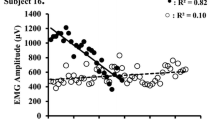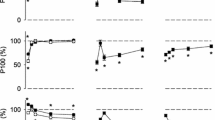Summary
The relationship between electrically evoked isometric and isokinetic properties of the triceps surae have been studied in 11 healthy male subjects. The results showed that the time to peak tension (TPT) and half relaxation time (1/2 RT) of the maximal twitch were 110±11 ms and 82±11 ms respectively, and the peak rates of rise of contraction (ΔP 50, ΔP 200) and relaxation (ΔP R50, ΔP R200) at 50 and 200 Hz were 0.36±0.07, 0.48±0.08 and 1.27±0.33, 1.25±0.27% Po ms−1 respectively. The decline in force during a fatigue test was significantly (P<0.02) associated with the decrease in maximal relaxation rate (r=0.79). The TPT was significantly (P<0.05) and inversely related to ΔP 50 and ΔP 200. The mean angle specific torque-velocity relationship for the 11 subjects was adequately described by the empirical exponential equation of the form: V=16.5 (e −p/30.8−e −84.3/30.8) where V=velocity (rads s−1) P=torque (Nm). The only significant association found between the isometric and isokinetic properties of the muscle was between ΔP R200 and the torque expressed at a given velocity of 4 rads s−1. This lack of association between the two variables is difficult to explain with certainty but it is suggested that it may be due to the differential effects of Ca2+ release and uptake and cross-bridge turnover rate in the two situations.
Similar content being viewed by others
References
Bárány M (1967) ATPase activity of myosin correlated with speed of muscle shortening. J Gen Physiol 50:197–216
Blinks JR, Rudel R, Taylor SR (1978) Calcium transients in isolated amphibian skeletal muscle fibres: detection with aequorin. J Physiol 277:291–323
Buller AJ, Lewis DM (1965) The rate of tension development in isometric tetanic contraction of mammalian fast and slow skeletal muscle. J Physiol 176:337–354
Davies CTM, Mecrow IK, White MJ (1982) Contractile properties of the human tricep surae with some observations on the effects of temperature and exercise. Eur J Appl Physiol 49:255–269
Davies CTM, Thomas DO, White MJ (1985) Measurement of human muscle torque under isokinetic conditions using electrically evoked tetani. J Physiol 361:9P
Fugl-Meyer AR (1981) Maximum isokinetic ankle plantar and dorsal flexion torque in trained subjects. Eur J Appl Physiol 47:393–404
Hill AV (1938) The heat of shortening and dynamic constants of muscle. Proc Roy Soc (Lond) Ser B 126:136–195
Huxley, AF (1957) Muscle structure and theories of contraction. Prog Biophys 7:255–318
Ivy JL, Withers RT, Brose G, Mawell BD, Costhill DL (1981) Isokinetic contractile properties of the quadriceps with relation to fibre type. Eur J Appl Physiol 47:247–255
Luff AR (1981) Dynamic properties of the inferior rectus, extensor digitorum longus, diaphragm and soleus muscle of the mouse. J Physiol 313:161–171
Marsden CD, Meadows JC (1970) Effect of adrenaline on contraction of human muscle. J Physiol 207:461–499
Merton PA (1954) Voluntary strength and fatigue. J Physiol 123:553–564
Miller RG, Mirka A, Maxfield M (1981) Rate of tension development in isometric contractions of human hand muscle. Exp Neurol 73:267–285
Nistor C, Markhede G, Grimby G (1982) A technique for measurement of plantar flexion torque with the Cybex 11 dynamometer. Scand J Rehab Med 14:163–166
Perrine JJ, Edgerton VR (1978) Muscle force-velocity and power-velocity relationships under isokinetic loading. Med Sci Sports 10:159–166
Ranatunga KW (1982) Temperature dependance of shortening velocity and rate of isometric tension development in rat skeletal muscle. J Physiol 329:465–483
Sale D, Quinlan J, Marsh E, McComas AJ, Belanger AY (1982) Influence of joint position on ankle plantar flexion in human. J Appl Physiol 52:1636–1642
Sandow A (1965) Excitation contraction coupling in skeletal muscle. Pharmacol Rev 17:265–320
Simmons RM, Jewell BR (1974) Mechanics and models of muscular contraction. I: Recent advances in physiology. Number nine. Churchill, Livingstone Edinburgh, London, pp 87–147
Thomas DO, White MJ, Sagar G, Davies CTM (1987) Electrically evoked isokinetic plantar flexor torque in males. J Appl Physiol 63:1499–1503
Thorstensson A, Grimby G, Karlsson J (1976) Force-velocity relations and fibre composition in human knee extensor muscles. J Appl Physiol 40:12–16
Wickiewicz TL, Roy RR, Powell PL, Perrine JJ, Edgerton VR (1984) Muscle architecture and force velocity relationships in humans. J Appl Physiol 57:435–443
Author information
Authors and Affiliations
Rights and permissions
About this article
Cite this article
Thomas, D.O., Sagar, G., White, M.J. et al. Electrically evoked isometric and isokinetic properties of the triceps surae in young male subjects. Europ. J. Appl. Physiol. 58, 321–326 (1988). https://doi.org/10.1007/BF00417270
Accepted:
Issue Date:
DOI: https://doi.org/10.1007/BF00417270




